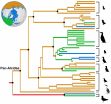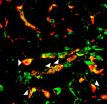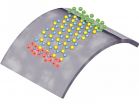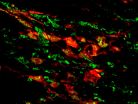A canary for climate change
Researchers find a strong correlation between Northern Hemisphere seabird diversity and environmental stressors
2014-10-15
(Press-News.org) Modern-day puffins and auks have long been recognized as environmental indicator species for ongoing faunal shifts, and fossil records now indicate that ancient relatives were similarly informative. Researchers have found that puffins and auks may have been at their most diverse and widespread levels during a relatively warm period of Earth's history. The results also explain how past extinctions have shaped the geographic distribution and population size of existing species.
Authors Adam Smith of the National Evolutionary Synthesis Center (NESCent) in Durham, N.C., and Julia Clarke of the University of Texas at Austin examined 28 extinct species in addition to 23 living species. Whereas previous research focused primarily on surviving members of the alcid family, this study was able to paint a more comprehensive picture of their evolution. The findings, which were just published online at the Journal of Avian Biology, support a connection between the diversification of wing-propelled diving seabirds and major climatic events. Such environmental conditions also appear to have influenced the physical traits observed in existing alcids like dovekies, murres, murrelets, puffins, auklets and auks.
The results indicate that the Pan-Alcidae clade, including all living auks and puffins as well as extinct species, first emerged about 35 million years ago. Through phylogenetic analyses of fossils and current species, the researchers were able to estimate "ghost lineages," a method of approximating gaps in the fossil record. By using ghost lineages to extrapolate species diversity over time, the scientists found that pan-alcid species enjoyed the most variety and widespread ranges about 15 million years ago during a period that climate scientists refer to as the Middle Miocene Climatic Optimum.
The researchers found that the geographic distribution and population size of modern alcids are primarily the result of extinctions corresponding with climate and ocean shifts over the last 5 million years. As ocean circulation changed and water surface temperatures cooled dramatically throughout a series of ice ages, species diversity bottlenecked for both Atlantic and Pacific Ocean species. More than 50 percent of species went extinct at this time, which roughly coincided with changes in ocean basin circulation, such as the onset of Gulf Stream circulation. The results contextualize contemporary changes in geographic range and decreases in population sizes of seabirds due to global warming and overfishing.
Smith and Clarke also considered the evolution of wing-propelled diving—a rare behavior found in only one-half percent of all birds. Previously assumed to be a nascent feature of the earliest alcid species, underwater diving could have first arisen as an escape tactic rather than a feeding strategy, according to the study results. Relatives like seagulls and terns plunge from the air, whereas modern puffins and auks dive from a floating position. By reconstructing the ancestral diet, the authors found that early species most likely fed on vertebrates close to the surface; they hypothesize that alcids gradually began to dive deeper and hunt invertebrates such as crustaceans and shrimp, which are included in the diet of some modern species.
The study elucidates how extinct alcids were affected by climate change and other environmental pressures—an area that has been somewhat neglected. Smith and Clarke hope that the results will strengthen modern conservation efforts by lending context to the plight of their modern kin and other seabirds.
INFORMATION:
This work was supported by the National Science Foundation (DEB: 0949899) and by the National Evolutionary Synthesis Center (NSF EF-0905606).
This project was also funded by a National Science Foundation Grant (NSF DEB 0949897) "Collaborative Research: Wings to Flippers – Phylogenetics, character acquisition, and feather biomechanics in the evolution of wing-propelled diving" to Julia Clarke.
Smith, N. Adam and Julia Clarke (2014). "Systematics and evolution of the Pan-Alcidae (Aves, Charadriiformes)" Journal of Avian Biology. http://onlinelibrary.wiley.com/doi/10.1111/jav.00487/abstract
The National Evolutionary Synthesis Center (NESCent) is a nonprofit science center dedicated to cross-disciplinary research in evolution. Funded by the National Science Foundation, NESCent is jointly operated by Duke University, The University of North Carolina at Chapel Hill, and North Carolina State University. For more information about research and training opportunities at NESCent, visit http://www.nescent.org.
[Attachments] See images for this press release:

ELSE PRESS RELEASES FROM THIS DATE:
2014-10-15
COLLEGE PARK, Md. – A new analysis of global energy use, economics and the climate shows that without new climate policies, expanding the current bounty of inexpensive natural gas alone would not slow the growth of global greenhouse gas emissions worldwide over the long term, according to a study appearing today in Nature.
Because natural gas emits half the carbon dioxide of coal, many people hoped the recent natural gas boom could help slow climate change—and according to government analyses, natural gas did contribute partially to a decline in U.S. carbon ...
2014-10-15
This market effect erases the advantage of lower emissions from the natural gas itself, according to an unprecedented international comparison of computer simulations.
"The upshot is that abundant natural gas alone will not rescue us from climate change," says the lead author Haewon McJeon of the Department of Energy's Pacific Northwest National Laboratory (PNNL). Especially in the US advances such as hydraulic fracturing – pumping liquids into stone to break it up and release the gas, known as fracking – and horizontal drilling have led to bountiful natural ...
2014-10-15
UCLA researchers have discovered that some scar-forming cells in the heart, known as fibroblasts, have the ability to become endothelial cells — the cells that form blood vessels. The finding could point the way toward a new strategy for treating people who have suffered a heart attack, because increasing the number of blood vessels in the heart boosts its ability to heal after injury.
In studies involving mice, the UCLA team also found that a drug could enhance this phenomenon and improve the repair process after a heart attack.
The research is published in the ...
2014-10-15
New York, NY—October 15, 2014—Researchers from Columbia Engineering and the Georgia Institute of Technology report today that they have made the first experimental observation of piezoelectricity and the piezotronic effect in an atomically thin material, molybdenum disulfide (MoS2), resulting in a unique electric generator and mechanosensation devices that are optically transparent, extremely light, and very bendable and stretchable.
In a paper published online October 15, 2014, in Nature, research groups from the two institutions demonstrate the mechanical ...
2014-10-15
CHAPEL HILL – Researchers from the UNC School of Medicine have discovered that cells called fibroblasts, which normally give rise to scar tissue after a heart attack, can be turned into endothelial cells, which generate blood vessels to supply oxygen and nutrients to the injured regions of the heart, thus greatly reducing the damage done following heart attack.
This switch is driven by p53, the well-documented tumor-suppressing protein. The UNC researchers showed that increasing the level of p53 in scar-forming cells significantly reduced scarring and improved heart ...
2014-10-15
Removing a child's tonsils is one of the most common surgeries performed in the United States, with approximately 500,000 children undergoing the procedure each year. New research finds that children from lower-income families are more likely to have complications following the surgery.
In the first study of its kind to analyze post-operative complications requiring a doctor's visit within the first 14 days after tonsillectomy, researchers saw a significant disparity based on income status, race and ethnicity.
"Surprisingly, despite all children having a relatively ...
2014-10-15
WORCESTER, MA – An international group of scientists led by Gang Han, PhD, at the University of Massachusetts Medical School, has combined a new type of nanoparticle with an FDA-approved photodynamic therapy to effectively kill deep-set cancer cells in vivo with minimal damage to surrounding tissue and fewer side effects than chemotherapy. This promising new treatment strategy could expand the current use of photodynamic therapies to access deep-set cancer tumors.
"We are very excited at the potential for clinical practice using our enhanced red-emission nanoparticles ...
2014-10-15
Montréal, October 15, 2014 – An important scientific breakthrough by a team of IRCM researchers led by Michel Cayouette, PhD, is being published today by The Journal of Neuroscience. The Montréal scientists discovered that a protein found in the retina plays an essential role in the function and survival of light-sensing cells that are required for vision. These findings could have a significant impact on our understanding of retinal degenerative diseases that cause blindness.
The researchers studied a process called compartmentalization, which establishes ...
2014-10-15
Do you believe in science? Your faith in science may actually make you more likely to trust information that appears scientific but really doesn't tell you much. According to a new Cornell Food and Brand Lab study, published in Public Understanding of Science, trivial elements such as graphs or formulas can lead consumers to believe products are more effective. "Anything that looks scientific can make information you read a lot more convincing," says the study's lead author Aner Tal, PhD, "The scientific halo of graphs, formulas, and other trivial elements that look scientific ...
2014-10-15
During the 1930s, North America endured the Dust Bowl, a prolonged era of dryness that withered crops and dramatically altered where the population settled. Land-based precipitation records from the years leading up to the Dust Bowl are consistent with the telltale drying-out period associated with a persistent dry weather pattern, but they can't explain why the drought was so pronounced and long-lasting.
The mystery lies in the fact that land-based precipitation tells only part of the climate story. Building accurate computer reconstructions of historical global precipitation ...
LAST 30 PRESS RELEASES:
[Press-News.org] A canary for climate change
Researchers find a strong correlation between Northern Hemisphere seabird diversity and environmental stressors





